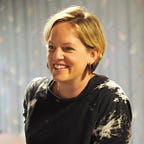The taste of a new regeneration
How We Eat in Melbourne: exploring regen food systems through the simple act of sharing a meal.
I’m a city kid, raised on groceries from shops with the big red hand, who struggles to identify 90% of what’s in the community garden behind my place. Others reading this can relate, right?
From 2022–2023 I had the great fortune to work with Moving Feast, helping grow their strategy for a regenerative food system in Victoria, Australia. And despite being a design consultant thrown in the content deep end for decades, I really felt my lack of knowledge this time, surrounded by actual farmers.
What is a regenerative food system, though? Last year I reposted Local Future’s definition: “…it is a food system that is small-scale, diversified, local, and people-led”. The strength of some replies revealed that ‘regen’ is a broad church full of strong opinions. For now I refer to Sustainable Table’s Regeneration checklist (p22), which asks questions instead of giving answers, e.g. “Does the action create more life or reduce it?”, and “Does it restore land or degrade it?”.
Helping on my regen food systems learning journey is Ashley Scarborough, the Berlin-based inventor of How We Eat, an exploration into the future of regenerative food through an interactive food experience. Ashley and I first met at the 2021 Berlin Global Goals Jam, as facilitators in the food systems and climate justice tracks. We’re also both alumni of the School of System Change.
How We Eat works like this: five courses are designed with a chef. Each course pairs and portraits principles and ingredients of a regenerative food system. Feasting together over a few hours, guests are also exploring reciprocity, biodiversity, collective action, living systems, and the flaws and possibilities of food systems. Deliciousness and enjoyment, with the goal of rethinking production and consumption, and applying regenerative principles in our lives.
Ashley has run How We Eat with groups in Germany, Sweden and the UK. In a 2023 interview with Ashley, re:gen-u observed: “the absence of a clear narrative describing the day-to-day experience of a regenerative economy hinders its adoption. Designers, storytellers, and writers can help create an emotional and visualized story that highlights the benefits of regenerative practices over the current capitalist model.”
As one of those designers, I’m excited to trial Ashley’s method in Australia, “portraiting regen foods” in the words of Serenity Hill, Open Food Network co-founder and Moving Feast partner. Already I’ve learned a tonne about foods I’ve barely heard of — all I’ve regrettably never tasted – and I’m thinking about where they might show up in a local How We Eat feast. Aniseed myrtle, sea celery, saltbush, boobialla, karkalla… all with deeply rooted ecological, social and cultural histories.
But at the end of the day, I don’t know the first thing about these foods (see: city kid), and it shouldn’t be me making calls on how or why they show up in the meal. Maybe the five-course format is not even appropriate?
In trying the method in Australia, centering of Indigenous food sovereignty is critical: the right of Traditional Owners to define their own food system. As the Greater Melbourne City Portrait highlights, a regenerative food system (in Naarm/Melbourne) must acknowledge and reflect that all food grown, shared and processed in Australia is on unceded Aboriginal land.
So the next step is to work with bush food businesses, right? Yes and no. Demand for bush food is booming in Australia, and many native food businesses have sprung up in recent years, but as Foodprint Melbourne’s 2022 report highlights, they risk repeating the injustices of the past, with only a small amount of businesses being Indigenous-owned and controlled. One of Foodprint’s key recommendations is supporting Victorian Traditional Owners to recover and apply knowledge and practices of traditional food production. This is the next major step for progressing How We Eat here in Melbourne. Standby for developments.
In the meantime, I am supporting and learning from these Indigenous-owned businesses – you can too:
https://www.blackduckfoods.com.au/
Kate Goodwin is a Melbourne-based designer working for fair and equitable climate and community futures. More at https://www.matchboxstudio.com.au/
